Best Tools and Gadgets for People Living in Small Apartments
🏠 Introduction
Living in a small apartment has its perks: less to clean, lower bills, and a cozy vibe that bigger homes often miss. But it also comes with a unique set of challenges. Where do you store your winter clothes? How do you fit a workspace into your living room? Is it possible to cook a full meal in a kitchen the size of a closet?
If you’ve ever looked around your place and thought, “I just need more room” — you’re not alone. But here’s the thing: it’s not always about having more space. It’s about using the space you already have in smarter ways.
Whether you’re living in a studio, a shared flat, or a micro-apartment, there are tools and gadgets that can help you live more comfortably without sacrificing your style or sanity. You don’t need to spend a fortune or turn your place into a furniture showroom. You just need a few well-thought-out items that solve real problems.
This guide walks you through the best space-saving tools, clever organizers, and compact appliances that actually make small apartment life easier — without making it feel even smaller.
🔄 Living Smart in a Small Space
The goal isn’t just to fit more. It’s to make what fits actually work.
When space is limited, every inch matters. The floor is already taken by your bed, your table, your couch — maybe even all at once. So you have to start thinking differently. Ask yourself:
- Can this item do more than one thing?
- Can I fold it away when I’m not using it?
- Am I using my walls, doors, or corners enough?
Here are a few common problems small apartment dwellers face — and what kinds of tools and gadgets can help fix them:
Problem #1: Not enough storage
You can only stuff so much under the bed or on top of the closet. The trick is finding places you didn’t realize were usable — like behind a door, under the sink, or along the wall. Wall-mounted organizers, foldable bins, and hanging shelves can make these spots work harder.
Problem #2: No room for full-sized furniture
A bulky desk or dining table eats up space you don’t have. That’s where foldable and collapsible furniture comes in. These are items that show up when you need them — and disappear when you don’t. A folding wall desk or a drop-leaf table can totally change how you use a room.
Problem #3: Tiny kitchen, limited counters
In small kitchens, counter space is sacred. You want tools that multitask and don’t hog space. Think cutting boards with built-in containers, stackable pots and pans, or one device that can chop, slice, and grate.
Problem #4: Appliances that don’t fit
A full-sized washer or air purifier might not be realistic in your apartment. But there are compact versions that do the job just as well. Look for small-but-powerful gadgets designed for tight spaces.
In the next sections, we’ll go through the most useful categories one by one — starting with foldable furniture that helps you reclaim your living space.
🪑 Foldable Furniture: Big Function, Small Footprint
When every square foot counts, flexibility is everything.
Furniture doesn’t have to be permanent. If you’re living in a small apartment, fixed furniture can feel like it owns the space — not the other way around. That’s where foldable furniture changes the game.
These are pieces you can open up when needed and fold down or tuck away when you don’t. They help you create a flexible home where rooms serve multiple purposes: your kitchen becomes your office, your living room becomes a dining area, and your bedroom becomes… well, everything.
Here’s how it works and what to look for.
🧠 Why Foldable Furniture Makes Sense
- You get your space back. When you’re done working, eating, or doing yoga, fold it up and boom — more room to breathe.
- It’s usually lighter and easier to move. Rearranging furniture in a small apartment can feel like playing Tetris. Foldable items are often simpler to shift or store.
- It’s ideal for renters. No need to drill holes or commit to a setup. Just unfold, use, and stash.
📋 What to Look For
Not all foldable furniture is created equal. Look for these traits:
Sturdy when unfolded – Wobbly tables defeat the purpose. Solid build quality matters.
Slim when folded – The whole point is to save space. Check the collapsed dimensions.
Easy to open/close – If it takes five minutes to set up, you won’t use it.
Neutral design – You want it to blend in, not take over the room.
Examples That Work in Real Life
1. Wall-Mounted Folding Desks
Perfect for remote work setups or study corners. These desks fold down when needed and tuck flush against the wall when not. Some even have small shelves built in for a few books or devices.
✔ Good for: Small bedrooms, entryways, or even kitchens.
📏 Space saved: Can reduce footprint from 3–4 feet to just a few inches.
2. Drop-Leaf Dining Tables
These tables have fold-down sides, so you can use them as narrow consoles most of the time and open them up when you have guests or need a larger workspace.
✔ Good for: Studio apartments or eat-in kitchens.
📏 Tip: Some drop-leaf models also have storage in the center, which doubles the value.
3. Collapsible Chairs and Stools
Lightweight, foldable chairs are a must if you have visitors once in a while but don’t want extra seating eating up space daily. There are also folding stools that tuck under tables or beds.
✔ Good for: Extra seating during dinner or game night.
📦 Storage idea: Hang them on wall hooks or store behind a closet door.
4. Foldable Beds or Sofa Beds
Murphy beds (wall beds) or convertible sofas are more of an investment, but they’re excellent if you need a dual-function living/sleeping area. Some come with built-in shelves or drawers for extra utility.
✔ Good for: Studios or guest-friendly setups.
🛏 Bonus: You can still get a good night’s sleep — just don’t go ultra-cheap with the mattress quality.
If you’re short on space and money, start small. A folding desk or drop-leaf table is usually affordable and makes a big difference. Build from there. You don’t need to transform your whole apartment overnight.
Next, we’ll look at how to use walls as storage with clever, space-saving organizers — often overlooked, but incredibly effective.
Foldable furniture is a must-have when you need every room to do double or even triple duty. Whether you’re working from home or trying to squeeze in a dinner table, choosing pieces that disappear when not in use can give you the flexibility to live more comfortably in less space.
Clamshell 48" Wall-Mounted Folding Desk
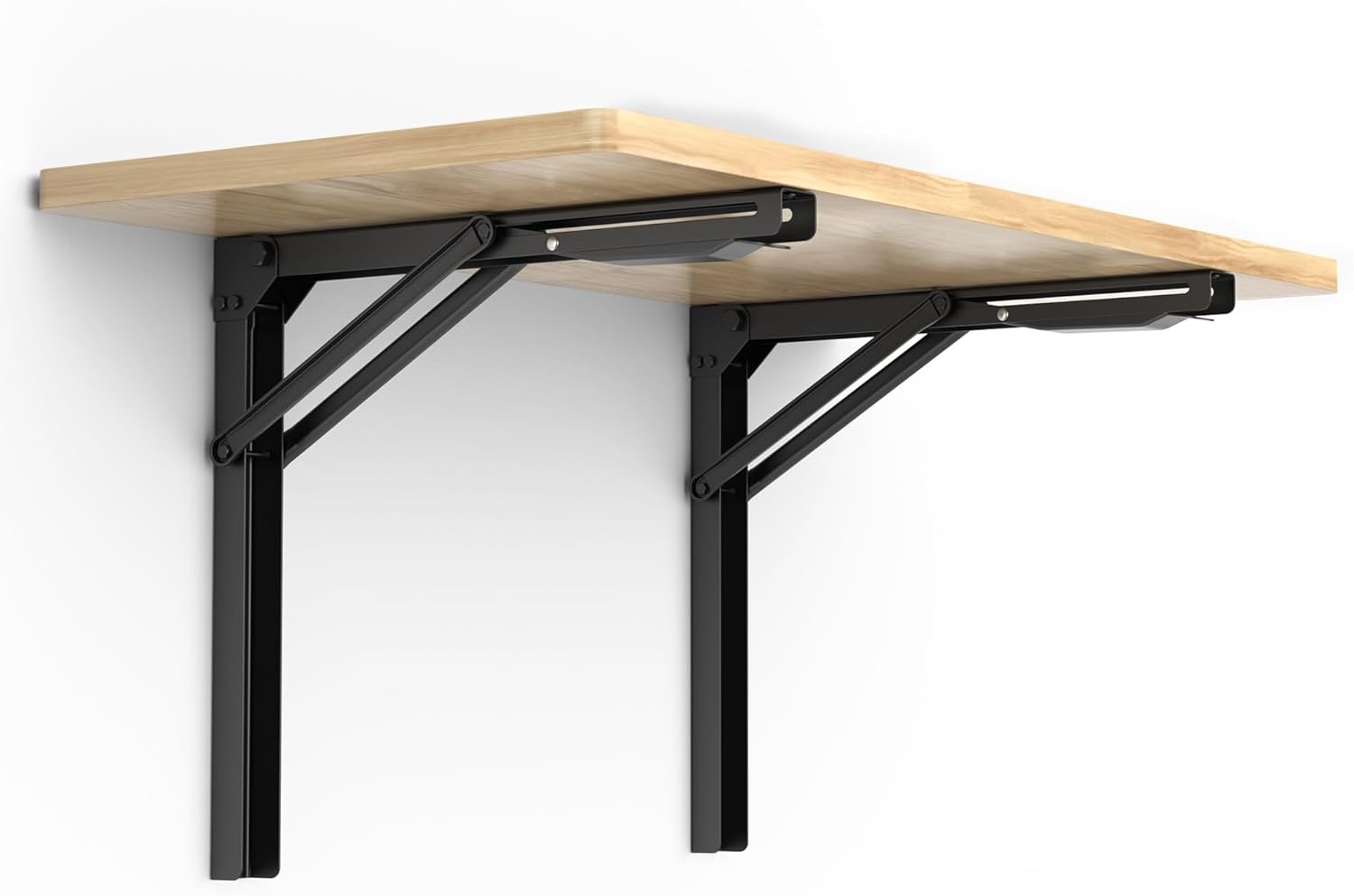
This folding desk mounts directly onto your wall and folds down into a fully functional workstation. When closed, it sits flush and looks like a decorative wooden panel, blending in nicely with most interiors. The surface is spacious enough for a laptop and notepad, with a small shelf inside for organizing essentials like pens or chargers. It’s made from high-quality birch plywood and has a minimalist design that doesn’t overpower a room.
Ideal for: People who work from home but don’t want a permanent desk eating up space in their bedroom or living room.
SWTOM Drop-Leaf Dining Table with Storage and Chairs
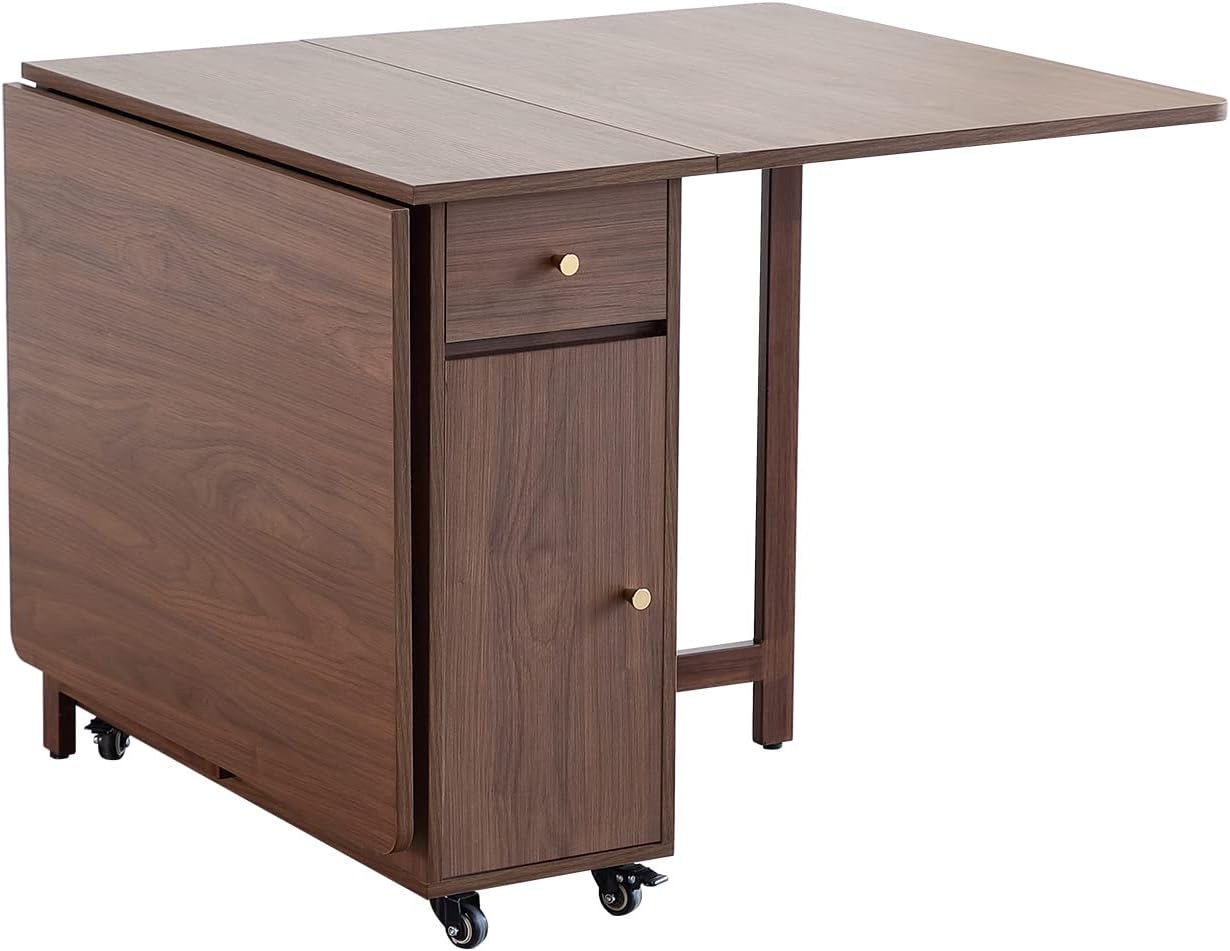
A compact dining solution for tiny kitchens or multipurpose rooms. This table features two drop-down sides, so it can function as a slim console table when not in use. It also comes with four chairs that store neatly inside the base. There’s even a little cabinet built in — perfect for tableware or linens. The build is sturdy, and the locking mechanism for the leaves holds well even with daily use.
Ideal for: Small apartments that need a dining area only occasionally, or for anyone who wants extra chairs but nowhere to store them.
🧱 Wall-Mounted Organizers: Use Your Vertical Space
One of the biggest mistakes people make in small apartments? Ignoring the walls. If your floor and cabinets are packed, your walls are often your last — and best — option.
Wall-mounted organizers help turn unused vertical space into smart storage without adding clutter. They can hold everything from kitchen tools to bathroom supplies, entryway items, office gear, and more. The right wall system can clean up your space and keep things within easy reach.
📌 Why It Works
- It keeps stuff off the floor. Less floor clutter = more room to walk, stretch, or just feel less boxed in.
- It’s easy to customize. You can mix and match hooks, shelves, and baskets depending on your needs.
- It’s renter-friendly. Many options use adhesive strips or over-the-door mounts — no drills required.
🧰 What to Look For
- Modular or adjustable pieces – So you can move things around as your needs change.
- Weight limit – Always check how much weight it can safely hold, especially with adhesive mounts.
- Material – Go for something sturdy like metal or solid plastic. Cheap wire racks often sag.
- Ease of installation – Look for no-drill setups if you’re renting.
✅ Useful Wall-Mounted Organizers (and How to Use Them)
🔲 Pegboards & Grid Systems
These are flexible, open systems you can adjust as your needs change. You attach the board to the wall, then add hooks, trays, or baskets.
- Best for: Tools, art supplies, kitchen utensils, keys, sunglasses, or mail.
- Where to use: Entryways, offices, kitchens, hobby corners.
- Why it works: You get a clear view of everything, and it’s easy to rearrange.
- Tip: Choose a board with enough attachment options — the cheaper ones are often too limited.
🚪 Over-the-Door Organizers
These are racks or pocket panels that hook onto the top of a door — no screws or tools required.
- Best for: Shoes, toiletries, cleaning supplies, snacks, small tech items.
- Where to use: Bathroom, pantry, bedroom closet, laundry area.
- Why it works: You instantly gain vertical storage without drilling or permanent changes.
- Tip: Make sure your door can still close with it — some thick racks block hinges.
🪵 Floating Shelves
Clean-looking shelves that attach directly to the wall. You can use one or stack several vertically.
- Best for: Books, plants, folded clothes, small decor, or storage bins.
- Where to use: Living room, bedroom, hallway, above a desk or toilet.
- Why it works: They keep things off the floor and help reduce visual clutter.
- Tip: Don’t overload them — use lightweight items to avoid sagging or pulling the anchors out.
🧲 Magnetic Strips & Rails
Mounted strips or horizontal rails with hooks or containers. Originally designed for kitchens, but useful almost anywhere.
- Best for: Knives, utensils, scissors, metal tools, or even spice jars with magnetic lids.
- Where to use: Kitchen backsplash, bathroom, or inside cabinet doors.
- Why it works: Keeps everyday items right where you need them, and frees up drawers.
- Tip: For renters, look for adhesive-backed options that don’t damage tiles or walls.
🧺 Wall-Mounted Baskets & Racks
These provide deeper storage than a shelf and are great for loose or bulky items.
- Best for: Towels, produce, rolled-up t-shirts, extra TP, or reusable bags.
- Where to use: Bathroom, kitchen, or laundry nook.
- Why it works: You get open, breathable storage — especially useful when floor or cabinet space is tight.
- Tip: Go for metal or mesh baskets that let you see what’s inside.
This setup lets you turn your walls into real working storage — not just decoration. In a small apartment, it’s often the difference between a cluttered mess and a livable space.
Wall space is often the most underutilized area in small homes. With the right organizers, you can turn a bare wall into a storage hub — without cluttering your floor or cramming more stuff into cabinets.
Ultrawall Pegboard Wall Organizer (48" x 36")
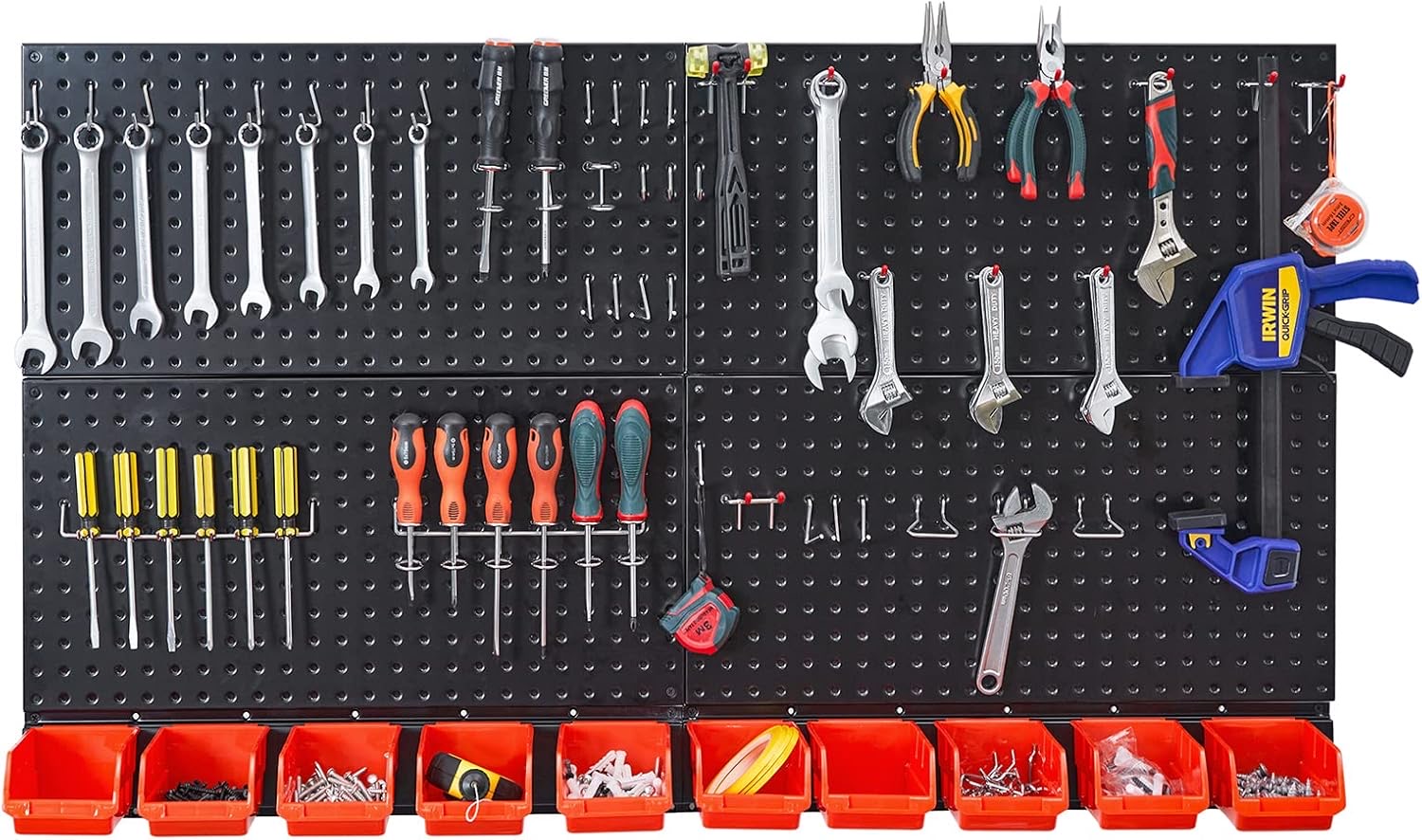
This heavy-duty pegboard system is ideal for organizing everything from kitchen tools to hobby supplies to office gear. Made from powder-coated steel, it’s strong enough to hold heavier items like pans, power tools, or bins full of craft materials. The modular layout allows you to reposition hooks and shelves whenever you like, making it highly customizable. It requires wall mounting, but once installed, it holds up extremely well.
Ideal for: People who want flexible storage solutions and aren’t afraid to drill into walls for the sake of long-term utility.
Gorilla Grip Over-the-Door Shoe Organizer (24 Pockets)
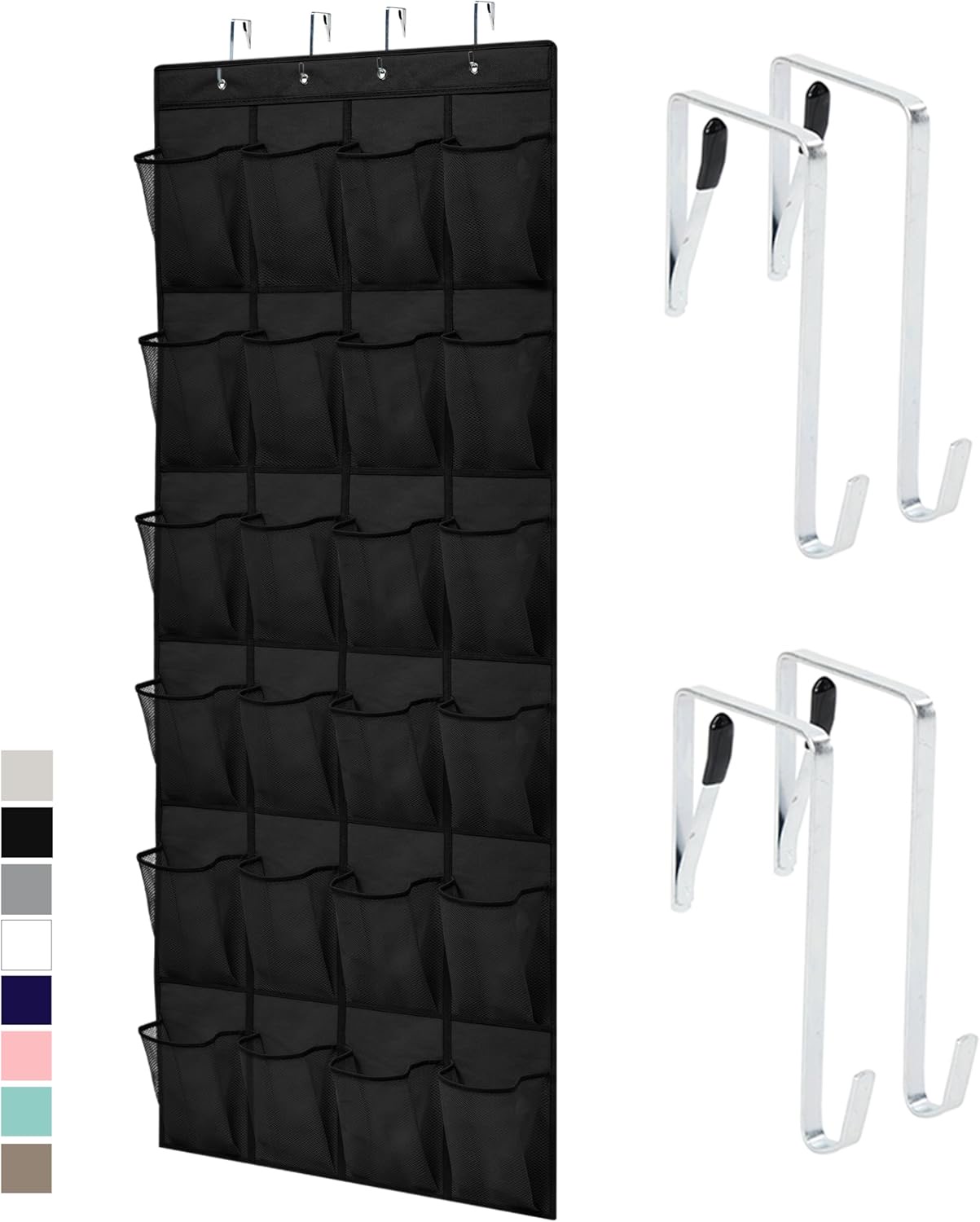
This is a simple but extremely effective organizer. The breathable mesh pockets can hold shoes, snacks, cleaning products, or even small electronics and cables. It’s designed to hang securely over standard interior doors without blocking them from closing. The reinforced stitching and strong hooks mean it won’t sag or tear with use — even when loaded up.
Ideal for: Renters or anyone who doesn’t want to drill but needs extra storage in the bathroom, pantry, or bedroom closet.
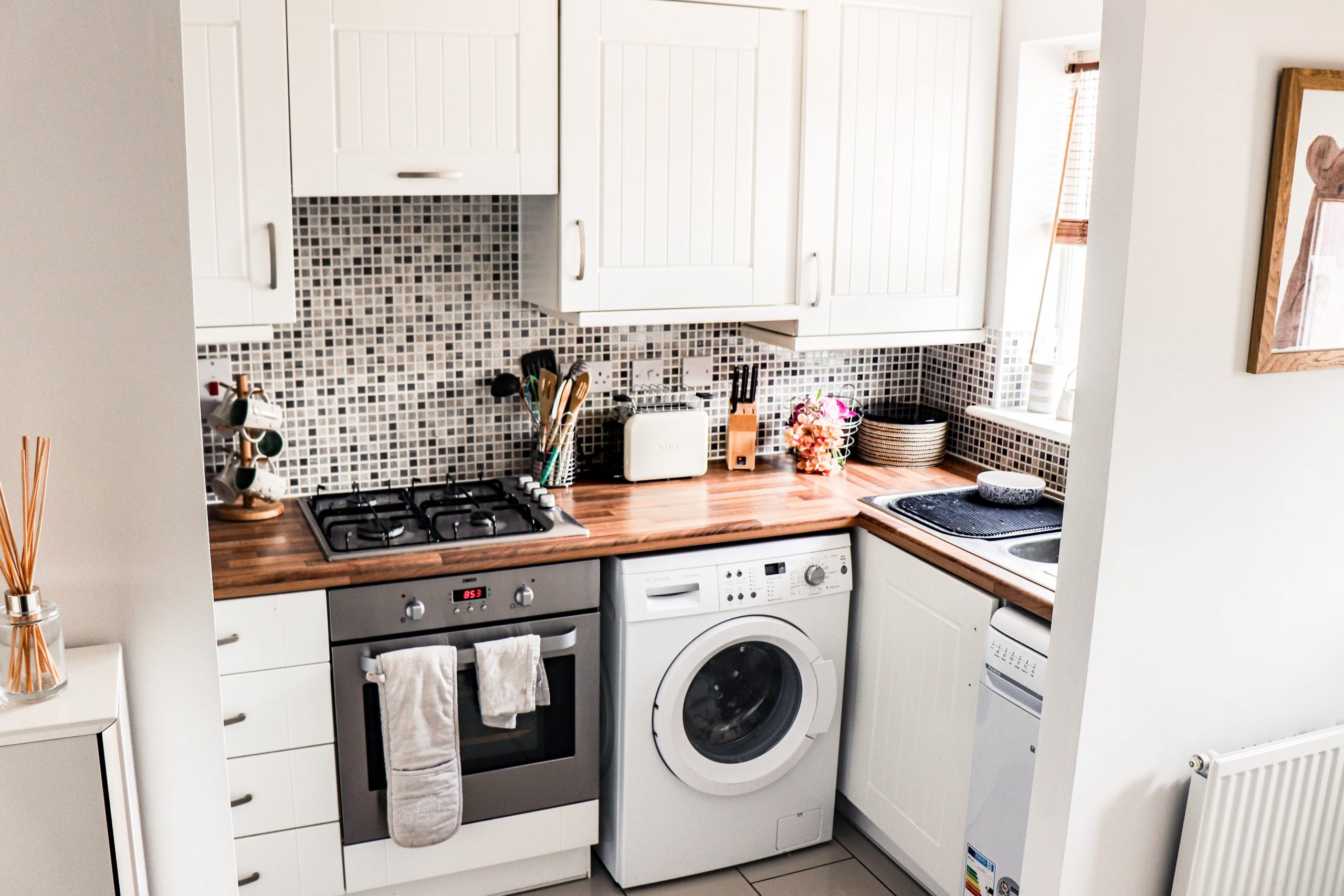
🍳 Multi-Purpose Kitchen Tools: More with Less
In a tiny kitchen, you don’t have room for single-purpose gadgets. That spiralizer you used once? It’s now eating up half a drawer. The goal in a small space isn’t to give up cooking — it’s to simplify how you cook by choosing tools that do more than one job.
Multi-purpose kitchen tools help you get things done faster, take up less space, and reduce the number of items you need to store. And that matters when every drawer, shelf, and inch of counter space counts.
🧠 Why Multi-Purpose Tools Matter in Small Kitchens
- They reduce clutter. Fewer items = more space for prep, storage, and movement.
- They’re budget-friendly in the long run. Instead of buying 5 gadgets, you get one tool that does the same.
- You’ll use them more often. Because they’re easier to grab, clean, and store.
🍴 Tools Worth Having (and Why)
🔪 1. All-in-One Vegetable Choppers
These usually come with multiple blades and containers so you can chop, dice, slice, and julienne without switching tools or making a mess.
- Replaces: Knife, cutting board, bowl, and separate slicers.
- Why it works: You can prep ingredients quickly and directly into a container — less cleanup and less mess on small countertops.
- Tip: Choose one with a non-slip base and dishwasher-safe parts to save time.
🍚 2. Stackable Cookware Sets
Stackable pots, pans, or nesting bowls let you store multiple items in the space of one. Some even share lids or handles.
- Replaces: Traditional bulky pots and mismatched lids.
- Why it works: You save cabinet space and avoid the daily frustration of lid-hunting.
- Tip: Avoid gimmicky sets. Look for high-quality non-stick or stainless options that nest tightly without wobbling.
🔄 3. Cutting Boards with Built-In Containers
These boards come with sliding or detachable trays so you can push chopped food straight into a container without needing extra bowls.
- Replaces: Cutting board + mixing bowls + counter cleanup.
- Why it works: It speeds up meal prep and keeps your counter organized.
- Tip: Choose a model with multiple containers if you prep more than one ingredient at once.
☕ 4. Manual Hand Blenders (with Attachments)
A good hand blender can blend, whisk, chop, and sometimes even puree soups — all without a full-size blender or food processor.
- Replaces: Stand mixer, blender, food processor.
- Why it works: It’s small enough to store in a drawer but powerful enough for most tasks.
- Tip: Check the attachment system — it should be secure and easy to clean.
🥘 5. Multi-Cookers (Rice + Steam + Sauté)
Compact multi-cookers can replace several bulky appliances. Even basic models can cook rice, steam veggies, and heat soup.
- Replaces: Rice cooker, steamer, soup pot, slow cooker.
- Why it works: You can “set and forget” while it cooks. Great when counter space is limited.
- Tip: If you’re not into pressure cooking, skip the complicated ones. Simpler models are often more space-efficient.
Before buying a new kitchen tool, ask yourself:
- Does it do more than one thing?
- Can I store it easily?
- Will I use it at least once a week?
If the answer’s no — it’s probably not worth your drawer space.
In a small kitchen, bulky single-use gadgets are more hassle than help. Multi-purpose tools save space, reduce clutter, and make cooking easier — without requiring a drawer full of gear.
Fullstar 6-in-1 Vegetable Chopper
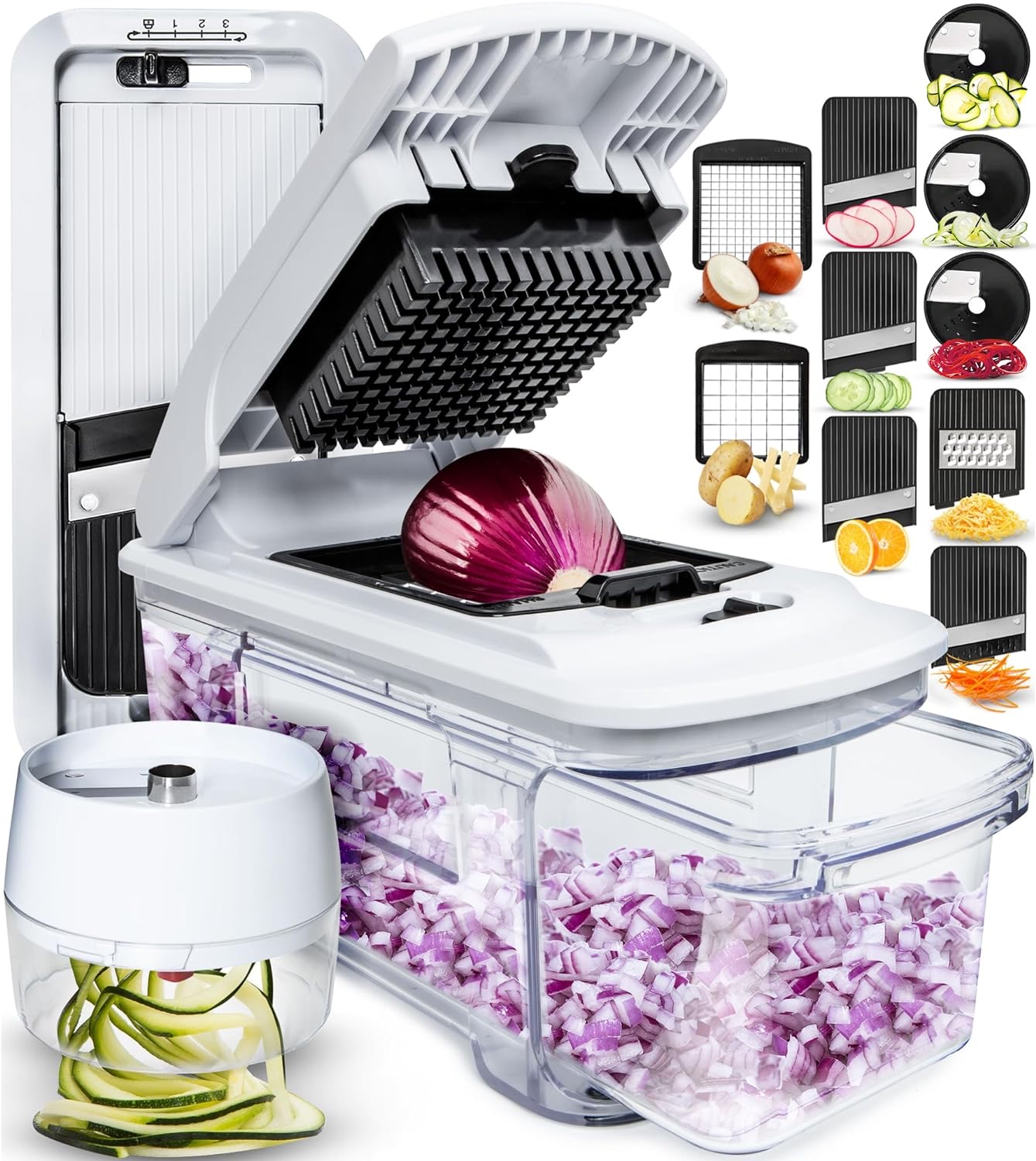
This manual chopper includes six interchangeable blades for chopping, slicing, grating, and julienning. It also comes with a built-in storage container, which keeps everything tidy and reduces prep mess. The lid locks firmly in place, and the non-slip base adds extra safety. The parts are BPA-free and dishwasher safe, which makes clean-up easy. It’s not electric, which is a bonus in small kitchens where outlets are limited.
Ideal for: Anyone who regularly preps vegetables and wants to speed up cooking without needing an electric food processor.
T-fal Ingenio 22-Piece Stackable Cookware Set
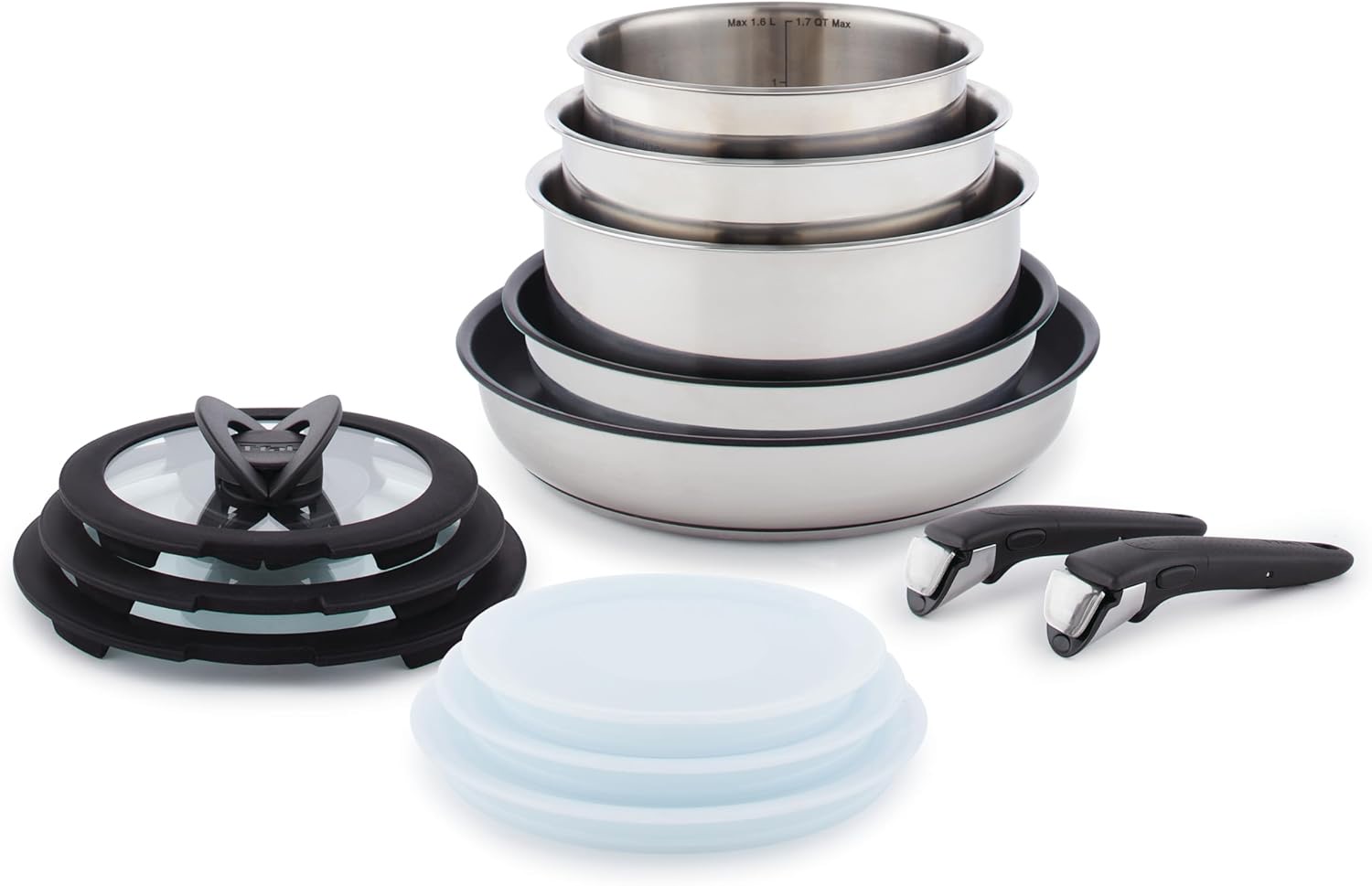
This non-stick cookware set is specifically designed to nest together, saving massive cabinet space. It includes a variety of pots and pans with detachable handles, so you can go from stovetop to oven to table easily. The shared lids snap on tight, and the pots stack perfectly flat. The coating is long-lasting, and the detachable handles feel sturdy and lock in with a satisfying click.
Ideal for: People with limited kitchen storage who still want to cook full meals without juggling mismatched pans and loose lids.
Compact Appliances That Work Hard
When you live in a small apartment, every appliance has to earn its place. Big machines may offer more power or capacity, but they come with a major downside: they take up space you probably don’t have.
Compact appliances are designed with smaller homes in mind. They do the job, take up less space, and are usually easier to move, store, and clean. But not all small devices are created equal. Some are underpowered or break easily. Others are cleverly designed, durable, and surprisingly efficient.
Here’s what actually works in real life — and why it matters.
🧺 Small-Space Laundry Solutions
If you don’t have a dedicated laundry room (most small apartments don’t), a compact washer or mini spin dryer can be a game changer. There are models small enough to tuck into a corner or store in a closet, yet powerful enough to handle daily laundry loads.
Some are manual and require no electricity — useful if you’re cutting down on energy use or living in a place with limited outlets. Others plug in and handle both washing and spin-drying. They won’t replace a full-size machine, but they can definitely reduce trips to the laundromat.
The key here is to match your needs. If you’re only washing a few things at a time — gym clothes, undergarments, kitchen towels — a small washer does the trick without hogging your floor.
🍞 Kitchen Appliances That Pull Double Duty
In a small kitchen, counter space is like gold. A full-sized oven may be out of the question, but a well-made toaster oven or multi-cooker can easily pick up the slack.
Toaster ovens today aren’t just for toast. Many now include convection cooking, baking, and broiling. You can roast vegetables, heat leftovers, and even bake small batches of cookies — all in one appliance that fits on a shelf. Some models are just tall enough to roast a chicken or bake a pizza, which is plenty for one or two people.
Similarly, small rice cookers that double as steamers and soup makers can handle everything from breakfast oatmeal to dinner rice bowls with veggies — all while using a footprint smaller than most coffee machines.
🌬 Clean Air Without the Bulk
Air quality matters, especially in smaller spaces where poor ventilation can be a problem. But full-sized air purifiers are often too large and loud for a small apartment.
Compact air purifiers are a solid alternative. They’re designed for single rooms and can sit quietly on a shelf or nightstand. Despite their size, they still manage to filter dust, smoke, and allergens — especially if they use HEPA filters. You may not need a whole-house system; sometimes, cleaning the air in your bedroom or home office is all it takes to breathe easier.
Look for models that run quietly at night and don’t need expensive replacement filters. Bonus if they offer smart features, like auto-sensing air quality or timer functions.
🎛 Choosing the Right Compact Appliance
It’s not just about size. A compact appliance should be easy to store, efficient at what it does, and worth using often. If it solves a real problem without adding clutter, it’s usually worth the space.
Here’s a simple rule: if you find yourself constantly moving something out of the way to use your counter, it probably doesn’t belong there. Choose the tools and machines you reach for every day — not just the ones that sound cool.
Some appliances are essential — but full-size models just don’t make sense in a small apartment. Compact versions can do the same job without taking over your space or costing a fortune.
Pyle 2-in-1 Compact Washer & Spin Dryer
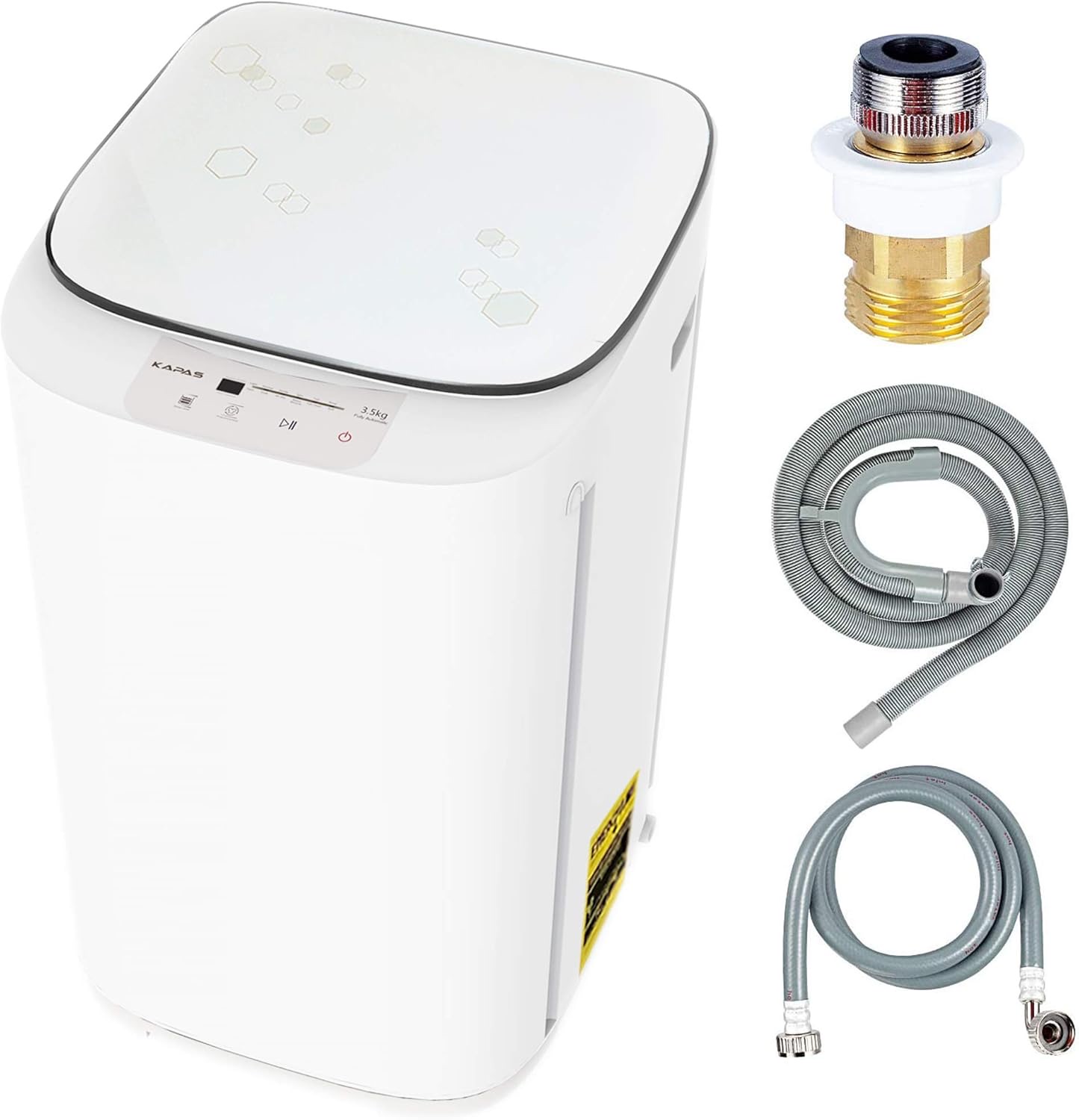
This portable machine includes two tubs: one for washing and one for spinning clothes dry. It’s compact enough to fit in a bathroom or closet, and light enough to carry when empty. Setup is easy — it doesn’t require any plumbing, just a bucket or sink for water in and out. While it won’t handle bulky loads, it’s perfect for everyday items like shirts, underwear, and workout clothes. The spin dryer is surprisingly effective, and clothes dry quickly on a rack afterward.
Ideal for: Small households or anyone without in-unit laundry who’s tired of hauling laundry bags to the laundromat.
Clorox Tabletop True HEPA Air Purifier
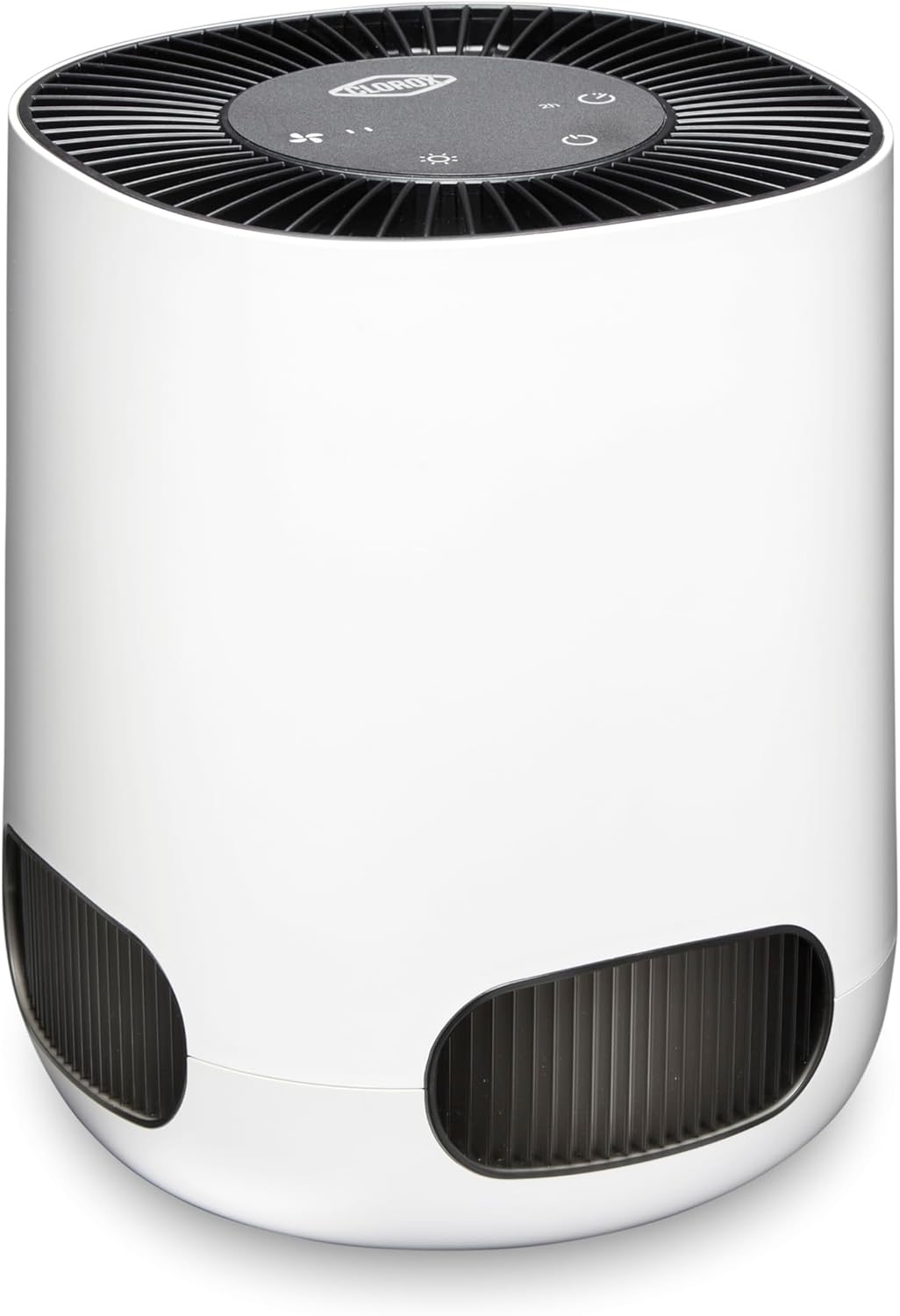
Don’t let the size fool you — this compact purifier uses a real HEPA filter to trap dust, allergens, and even smoke particles. It’s quiet on low settings, has a sleep mode, and includes a timer function. It’s sized for bedrooms or home offices, and doesn’t eat up shelf space. Filter replacements are affordable and easy to swap out.
Ideal for: Allergy sufferers or anyone living in a small apartment where clean air matters but space is tight.
Everyday Habits That Save Space
You can have the best tools and clever gadgets, but if your daily habits don’t match your space, clutter builds up fast. In a small apartment, how you live becomes just as important as what you live with.
Small changes in your routine can create more breathing room without buying a thing. These habits take almost no effort once they’re part of your day — and over time, they help your home feel less cramped, less messy, and a lot more livable.
🧺 1. Store Things Where You Actually Use Them
It sounds obvious, but it’s often overlooked. Keep cooking tools near the stove. Keep towels near the bathroom sink. Don’t stash your vacuum in the farthest corner of your closet if you use it often.
When things are easy to grab and put away, they’re less likely to end up on the floor or piled somewhere. This one small shift can prevent mess before it starts.
🧻 2. Use “Dead Space” for Storage
Most apartments have little areas that go unused: under the bed, on top of cabinets, behind doors, even under the couch. These spaces are perfect for items you don’t need every day — like winter gear, extra bedding, or bulk supplies.
Rolling storage bins, slim baskets, or vacuum bags work great here. Just label things clearly so you don’t forget what’s where.
🧦 3. Fold or Roll Clothes the Smart Way
Traditional folding takes up more space than you think. Rolling clothes, or using vertical folding (like in drawer organizers), lets you see everything at a glance and fit more into each drawer.
It’s especially helpful for socks, workout clothes, and shirts you wear often. You don’t need to get fancy — just stay consistent so you don’t waste time hunting for things.
🛍 4. Be Honest About “Just in Case” Items
If you’re keeping something only because “I might need this one day”, pause and think: When was the last time I actually used it? If it’s been over a year, chances are it’s costing you space without giving anything back.
It doesn’t mean you have to throw it out. But you might be better off storing it elsewhere — or letting it go completely.
🕒 5. Do Small Daily Resets
Take 5–10 minutes at the end of each day to put things back where they belong. That’s it. No deep cleaning, no pressure.
Clear the table, hang up the jacket you tossed on a chair, wipe the counter. These micro-routines stop clutter from piling up and make mornings feel more relaxed.
Good habits beat storage hacks. You don’t need a perfect home — just one that works for you. The more you match your space with how you actually live, the easier everything gets.
FAQ: Living Smart in a Small Apartment
What are the best ways to create more space without throwing things away?
Start by looking for unused space — under the bed, above cabinets, behind doors, and along walls. Use under-bed bins, wall-mounted shelves, and over-the-door organizers to turn those dead zones into useful storage. Also, replace bulky furniture with foldable or multi-use alternatives (like ottomans with storage or folding desks). You don’t always need to declutter aggressively — sometimes you just need better systems.
Are foldable furniture pieces durable enough for everyday use?
Yes, if you choose well-made options. Look for pieces with solid hinges, strong weight capacity, and positive long-term reviews. Wall-mounted desks and drop-leaf tables, in particular, are designed for regular use. Avoid super cheap plastic frames or overly thin materials — they may wobble or wear out quickly with daily folding and unfolding.
What should I prioritize in a small kitchen?
Focus on tools that do more than one job and appliances with a small footprint. For example, use a cutting board with a container, or a rice cooker that can also steam vegetables. Stackable cookware and nesting bowls save tons of cabinet space. Also, keep your most-used tools accessible and store rarely used items higher up or elsewhere.
Is a compact washer worth it?
For many people, yes — especially if you don’t have laundry in your building or want to avoid shared machines. A compact washer and spin dryer combo is usually big enough to handle daily essentials like shirts, socks, and gym clothes. It won’t replace a full-size machine for heavy items, but it can drastically cut down your trips to the laundromat.
Are small air purifiers actually effective?
Yes, but they’re designed for small rooms — think bedrooms, offices, or studio apartments. Look for models with a true HEPA filter and a clean air delivery rate (CADR) that matches the room size. Even compact purifiers can remove allergens, pet dander, smoke, and dust effectively if they run consistently.
How do I choose which items to buy when I'm on a budget?
Start with the areas where you feel the most frustration — maybe your kitchen counter is always cluttered, or you don’t have a spot to work. Fix those first with low-cost, high-impact tools like a foldable desk or over-the-door organizer. Avoid buying too many items at once. One or two smart upgrades can make a big difference. Also, look for multipurpose products — they save money and space.
How can I store off-season clothes or rarely used items in a small apartment?
Use vacuum storage bags or low-profile bins under your bed or couch. Stack storage boxes on closet shelves or above cabinets. Label everything clearly so you don’t forget what’s where. Some people also rotate seasonal items out to a friend’s place or rent a small storage unit, but you can usually make it work with just creative at-home storage.
I rent my apartment. Can I still install wall-mounted organizers?
Yes — just look for no-drill options. Over-the-door organizers, adhesive wall hooks, tension rods, and freestanding shelves are all renter-friendly. Some pegboards even come with command-strip mounting systems. If you do use screws or anchors, patching small holes when you move is usually simple and inexpensive.
Conclusion: Small Apartment, Smarter Living
Living in a small apartment comes with challenges — tight spaces, limited storage, multifunctional rooms — but it also offers a unique opportunity: the chance to live more purposefully, with less waste and more intention.
The real key to thriving in a small space isn’t just downsizing. It’s about designing your space to fit your life, not the other way around. The tools and gadgets we’ve looked at — foldable furniture, wall-mounted organizers, compact appliances, and multi-purpose kitchen tools — aren’t just clever space savers. They’re enablers of better routines, smoother mornings, and more breathing room in your day-to-day life.
But products alone aren’t enough.
If your home is filled with things you rarely use, no organizer in the world will solve that. That’s why good habits matter just as much. Choosing to reset your space each evening, keeping only what’s useful or meaningful, and storing things where you actually use them — these small, consistent decisions are what transform a cramped apartment into a well-functioning home.
And remember, your space doesn’t have to be perfect.
It doesn’t have to be Pinterest-worthy or fully optimized on day one. Start with what frustrates you most — maybe it’s the lack of counter space, nowhere to work, or clothes piling up. Fix one area at a time. One good product. One habit. One win. Over time, it builds into a space that supports you instead of stressing you out.
So whether you’re living alone in a studio or sharing a one-bedroom, the goal isn’t to just make space — it’s to make space work. With the right tools and a bit of intention, even the smallest apartment can feel open, organized, and yours.
